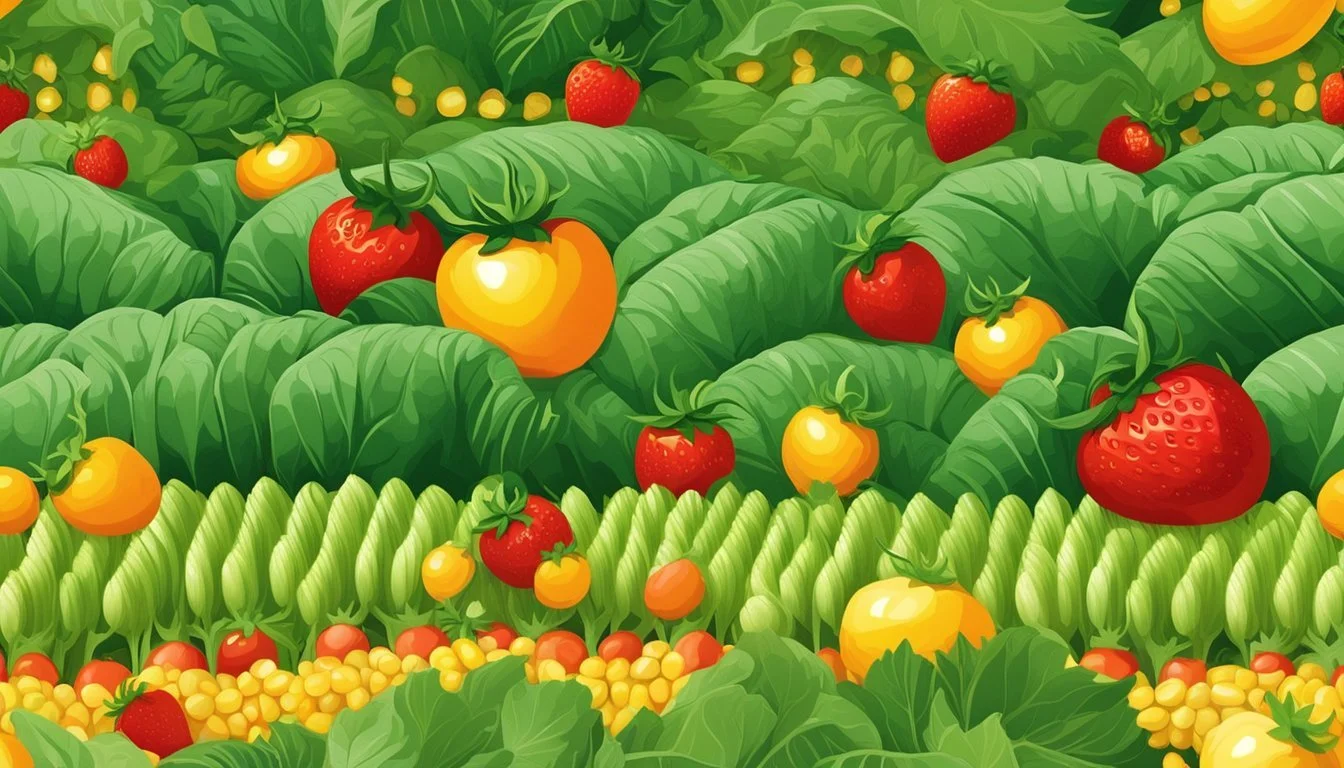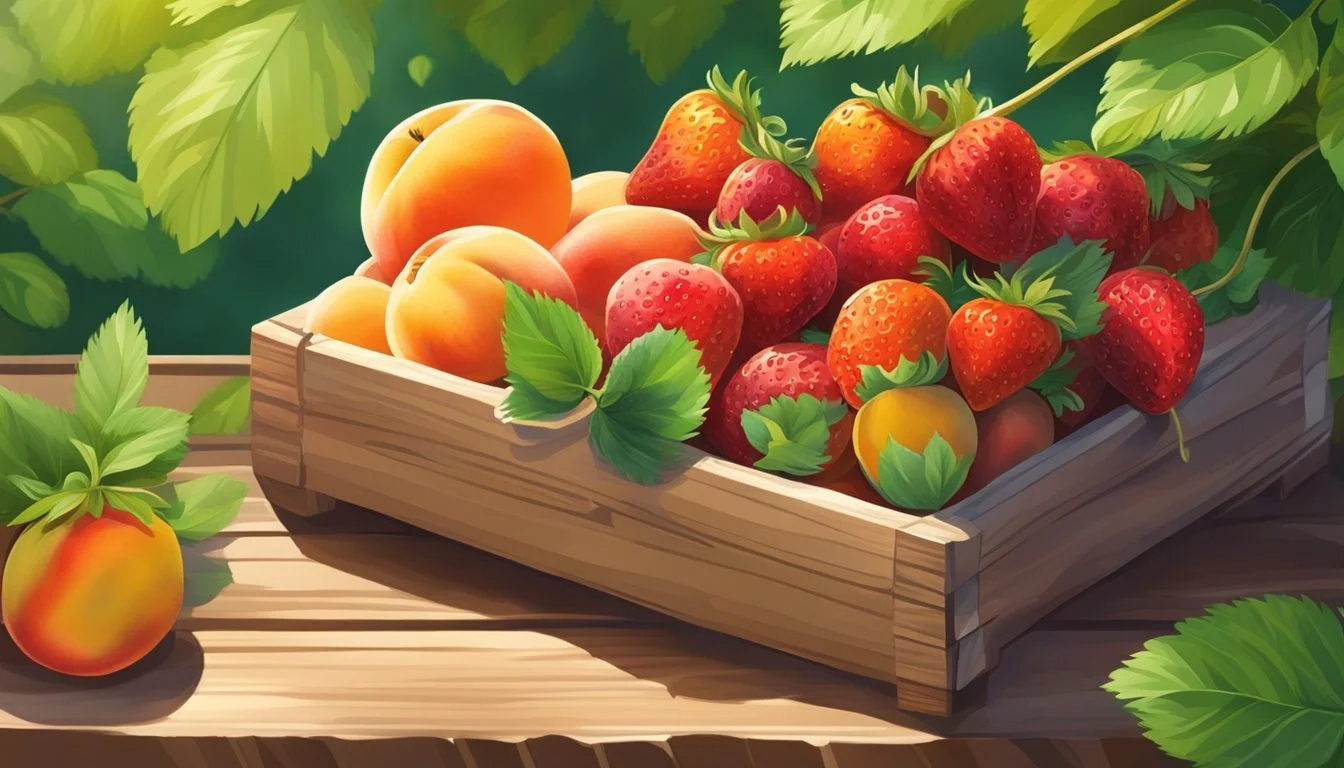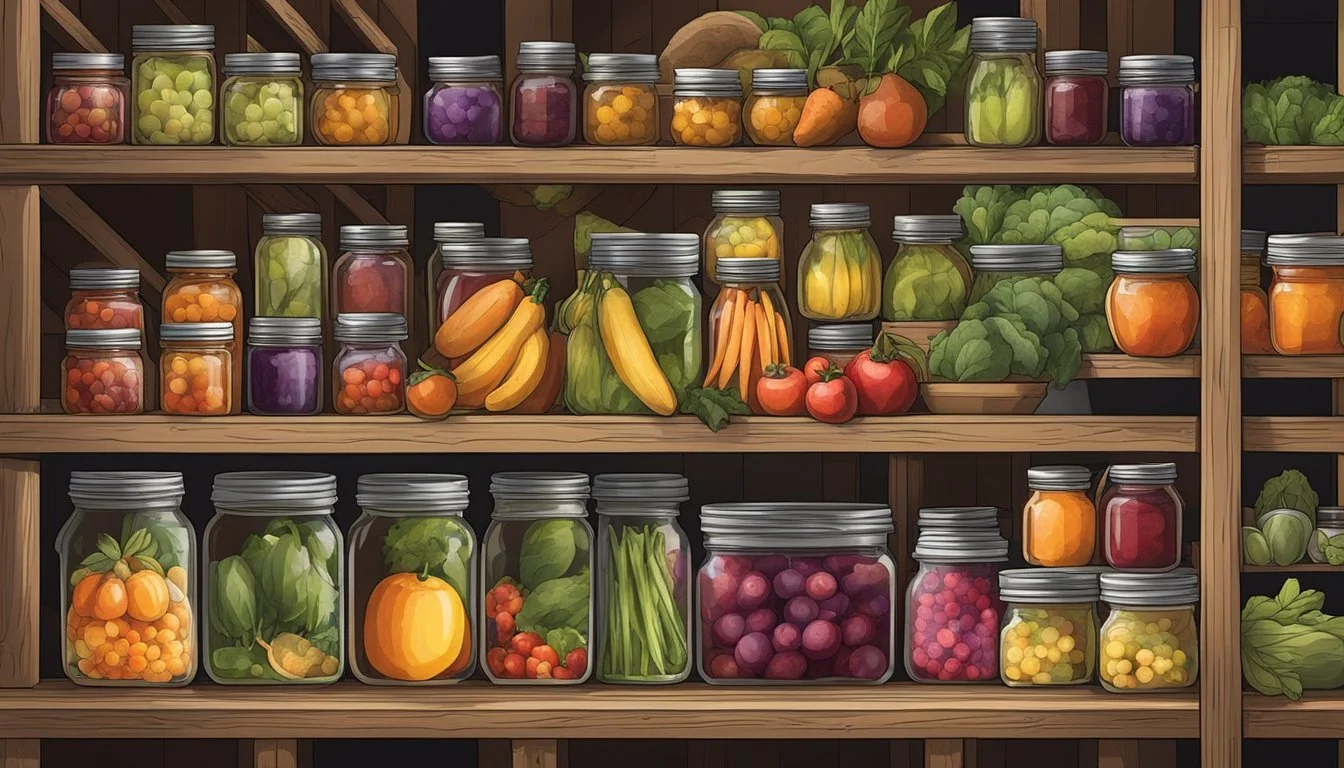Kansas Seasonal Fruit & Vegetables in June
Your Guide to Fresh Picks
This Article is Part of our Kansas Seasonal Fruit & Veg Calendar
In Kansas, the month of June heralds the arrival of a diverse array of seasonal produce that offers freshness and flavor to any table. As summer takes hold, the agricultural sector of the Sunflower State comes alive with a bountiful selection of fruits and vegetables, reflecting the region's rich farming heritage. Consumers seeking locally grown options have a plethora of choices that not only enhance the taste of their meals but also support the local economy and sustainable practices.
Among the offerings, one will find a colorful medley of vegetables. Broccoli, cabbage, and carrots are just a few of the nutritious staples that Kansas soil yields during this time. These vegetables not only represent the state's proficiency in crop production but also the opportunity for residents and visitors to enjoy produce at its peak ripeness. Vegetable enthusiasts can relish these fresh picks, assured by their source's proximity and seasonal suitability.
June in Kansas also marks a period when certain fruits begin to grace the markets, though the variety may be more limited compared to vegetables. Strawberries and cherries (how long do cherries last?) reach their peak, providing a sweet and tangy counterpoint to the earthier flavors of the seasonal vegetables. This balance of fruit and vegetable offerings encapsulates the essence of June's seasonal produce in Kansas, inviting everyone to partake in the fresh bounty that this midwestern gem has to offer.
Seasonal Fruits in June
In June, Kansas showcases a bounty of fruits that are at their peak of freshness and flavor. These fruits offer a combination of sweet, juicy tastes and high nutritional value, making them ideal for summer consumption.
Berries and Stone Fruits
Berries:
Blueberries: Small, deep blue berries known for their sweet-tart flavor and high antioxidants.
Strawberries: Bright red, juicy berries with a balanced sweetness, rich in vitamin C.
Stone Fruits:
Cherries: Dark red to purple, cherries are fleshy with a sweet and slightly tart flavor.
Peaches: Fuzzy skin with a sweet, aromatic flesh, peaches are a source of vitamins A and C.
Apricots: Small, golden-orange fruits with a velvety skin and a distinctly sweet and slightly tart flavor.
Plums: They come in a variety of colors and have a sweet and juicy taste with a hint of tartness.
Melons
Cantaloupe (how long does cantaloupe last?): The cantaloupe's netted skin encases a soft, orange flesh that's sweet and rich in vitamin A.
Watermelon: A summer staple, the watermelon has a green rind and a crisp, sweet, hydrating red or pink flesh.
Other June Fruits
Apples: Late varieties of apples begin to come into season, offering a crisp texture and a range of flavors from tart to sweet.
Grapes: Depending on the variety, grapes can be sweet or tart, enjoyed fresh or used in recipes.
Pears: Some early varieties of pears may start to appear with their soft, buttery flesh and subtly sweet flavor.
Seasonal Vegetables in June
June in Kansas brings a bounty of fresh, nutrient-rich vegetables. Gardens and farmers' markets begin to fill with a variety of produce, offering vibrant flavors and the best of summer nutrition.
Leafy Greens and Salad Vegetables
June heralds the peak season for leafy greens and salad vegetables. Consumers will find an abundance of:
Lettuce: Crisp and fresh, varieties range from Iceberg to Romaine.
Spinach: Rich in iron and versatile for both salads and cooked dishes.
Arugula: A peppery green, perfect for adding a kick to salads.
Kale: Loaded with vitamins A, K, and C, it's great for salads and smoothies.
Root Vegetables and Tubers
Kansas soil yields a selection of root vegetables and tubers that are both flavorful and nutritious. Among those, shoppers can expect to find:
Carrots (how long do carrots last?): Sweet and crunchy, ideal for snacking, roasting, or adding to salads.
Beets (how long do beets last?): Earthy and deep-red, they're great roasted or in salads.
Radishes: Offering a crisp, spicy note to dishes.
Turnips: Can be enjoyed both raw and cooked, adding a mild, piquant flavor.
Potatoes: A versatile staple for a multitude of cooking methods.
Summer Squashes and Plants
The warm temperatures bring on the growth of summer squashes and plants like:
Zucchini: Mild and perfect for sautéing, grilling, or zoodle-making.
Yellow Summer Squash: Slightly sweeter than zucchini, it's excellent grilled or roasted.
Cucumber: Cool and refreshing, cucumbers (how long do cucumbers last?) are a hydrating addition to summer dishes.
Podded Vegetables and Alliums
Finally, Kansas gardens provide a good selection of podded vegetables and alliums such as:
Peas: Sweet and tender, ideal for salads or as a gentle side dish.
Green Beans: Snappy and fresh, they are perfect for a quick sauté or a crunchy addition to salads.
Onions: Fundamental for flavor bases in many dishes.
Garlic: Robust and aromatic, essential for flavoring a variety of recipes.
Scallions: Also known as green onions, they add a mild, zesty touch to dishes.
Farming and Agriculture in Kansas
Kansas is known for its diverse agricultural output, which peaks during the summer months. The state's farming industry thrives despite the challenges posed by its varying climate, directly influencing the crop availability and quality.
Crop Availability
Kansas boasts a plentiful bounty in June, with farmers markets and local vendors stocked with fresh produce. Key summer crops include:
Fruits: cherries, strawberries, and blueberries
Vegetables: sweet corn, cucumbers, tomatoes, and zucchini
A visit to a Kansas farmers market in June offers an array of colors and flavors, with produce picked at peak ripeness.
Agricultural Regions and the Weather Impact
Climate plays a pivotal role in Kansas agriculture. The state experiences a range of weather conditions, from potential late spring cold snaps to intense summer heat. Farming regions in Kansas navigate these conditions as follows:
Eastern Kansas: Fertile soils support a variety of crops; however, weather here can be humid and precipitation levels higher, affecting plant diseases and growth cycles.
Western Kansas: This region is drier and requires irrigation practices, yet it's well-suited for hardy crops able to withstand less predictable rainfalls.
The farmers' ability to manage these weather variations directly impacts the state's produce quality and crop yields.
Health Benefits and Nutrition
Consuming seasonal fruits and vegetables in June from Kansas not only provides freshness but also offers numerous health benefits. These crops are often at their peak in nutrients.
Fruits
Strawberries: Available early in the month, they are rich in vitamin C, manganese, and dietary fiber.
Cherries: These contain vitamin C, potassium, and antioxidants, which may reduce inflammation.
Vegetables
Broccoli: A powerhouse of vitamins A, C, and K, fiber, and may support heart health.
Carrots: They are high in beta-carotene, which is converted to vitamin A in the body, supporting eye health.
Nutrients in Seasonal Produce
Nutrient Health Benefit Vitamin A Supports vision and immune function Vitamin C Aids in collagen production Potassium Regulates blood pressure Fiber Aids in digestion Antioxidants Combat oxidative stress
Eating fruits and vegetables in season from Kansas ensures one is getting a plethora of nutrients that are essential for good health. These nutrients aid in reducing the risk of chronic diseases such as heart disease, diabetes, and even certain cancers. Including a variety of these in one's diet can help meet dietary recommendations, providing many nutrients including folate and dietary fiber.
Preservation and Storage
In Kansas, the preservation and storage of seasonal produce in June is essential for extending the freshness and enjoyment of fruits and vegetables. Proper methods ensure that the abundance of the season's harvest can be savored throughout the year.
Canning and Freezing Techniques
Canning is a viable method for preserving the quality and nutrients of seasonal fruits and vegetables. High-acid foods such as tomatoes and certain fruits are best for canning, and they require a water bath canner. Vegetables, which are low-acid, generally require pressure canning to prevent the risk of foodborne illness.
Fruits: soft fruits like berries can be canned using a simple syrup solution.
Vegetables: pickling is a popular canning method that can be applied to cucumbers or beets.
Freezing is another preservation method that retains the flavor and nutrients of produce. Blanching vegetables before freezing is recommended to stop enzyme activities that can cause loss of flavor, color, and texture. Fruits can be flash-frozen on a tray before being stored in freezer bags to prevent clumping.
Fruits: peaches, strawberries, and cherries should be pitted and possibly sliced before freezing.
Vegetables: beans, corn, and peas are blanched for a few minutes and then cooled rapidly before freezing.
Proper Storage for Longer Freshness
For unprocessed fruits and vegetables, storage is key to maintaining freshness. Different produce has differing requirements for temperature and humidity, often necessitating separate storage areas.
Root vegetables like carrots and beets thrive in cool, moist environments such as root cellars where they can be stored for extended periods. Leafy greens should be kept refrigerated in a crisper drawer to maintain their moisture and crispness.
Here's a basic guide for optimal storage conditions for some common Kansas produce:
Root vegetables (e.g., beets, carrots): Store in cool, high-humidity conditions.
Leafy greens (e.g., lettuce, spinach): Keep in higher humidity, inside refrigerators.
Stone fruits (e.g., peaches): Ripen at room temperature, then refrigerate.
Berries: Refrigerate and keep dry to prevent mold growth.
It's crucial that air can circulate well around the produce to prevent moisture buildup and spoilage. Ensuring fruits and vegetables are dry before storage and using proper containers or bags can also make a substantial difference in prolonging freshness.






